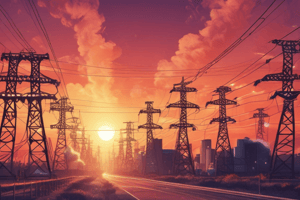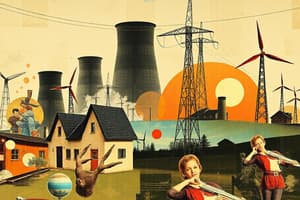Podcast
Questions and Answers
Who discovered the principles of electromagnetism in 1831?
Who discovered the principles of electromagnetism in 1831?
- Michael Faraday (correct)
- Thomas Edison
- Galileo Galilei
- Nikola Tesla
What is electricity best described as?
What is electricity best described as?
- A primary form of energy
- A renewable energy source
- A form of mechanical energy
- A secondary energy source (correct)
How does electricity travel?
How does electricity travel?
- As individual particles in an open space
- Randomly and unpredictably
- In closed loops or circuits (correct)
- Only in straight lines
What is required for electricity to flow according to the text?
What is required for electricity to flow according to the text?
Which category does nuclear energy fall into regarding electricity generation?
Which category does nuclear energy fall into regarding electricity generation?
What was the largest source of U.S. electricity generation in 2022?
What was the largest source of U.S. electricity generation in 2022?
Which renewable energy source accounted for the highest percentage of total U.S. utility-scale electricity generation in 2022?
Which renewable energy source accounted for the highest percentage of total U.S. utility-scale electricity generation in 2022?
Who demonstrated that lightning is electricity?
Who demonstrated that lightning is electricity?
What percentage of total U.S. electricity generation in 2022 was accounted for by geothermal power plants?
What percentage of total U.S. electricity generation in 2022 was accounted for by geothermal power plants?
Which energy source accounted for nearly one-fifth of U.S. electricity in 2022?
Which energy source accounted for nearly one-fifth of U.S. electricity in 2022?
Flashcards are hidden until you start studying
Study Notes
Electricity
Electricity is a secondary energy source that is produced by converting primary energy sources such as coal, natural gas, nuclear energy, solar energy, and wind energy into electrical power. It is an energy carrier that can be converted to other forms of energy such as mechanical energy or heat. Electricity is a basic part of nature and is one of the most widely used forms of energy.
Understanding Electricity
Electricity is the flow of electrical power or charge. It is the force that causes charged particles to move from one atom to another, and it is a controllable and convenient form of energy used in the applications of heat, light, and power. The science of electricity has its roots in the principles of electromagnetism, which were discovered by Michael Faraday in 1831.
Electricity travels in closed loops, or circuits, and it must have a complete path before the electrons can move. When a circuit is open, the electrons cannot flow. When a light switch is turned on, electricity flows through a tiny wire in the bulb, which gets very hot and makes the gas in the bulb glow.
Electricity Generation
Electricity is generated using various methods, including steam turbines, internal combustion engines, water wheels, and other similar machines. The three major categories of energy for electricity generation are fossil fuels, nuclear energy, and renewable energy sources. Most electricity is generated with steam turbines using fossil fuels, nuclear, biomass, geothermal, and solar thermal energy.
Fossil Fuels
Fossil fuels are the largest sources of energy for electricity generation. In 2022, natural gas was the largest source of U.S. electricity generation, accounting for about 40% of the total. Natural gas is used in steam turbines and gas turbines to generate electricity. Coal was the third-largest energy source for U.S. electricity generation, accounting for about 18%, and nearly all coal-fired power plants use steam turbines.
Nuclear Energy
Nuclear energy provided nearly one-fifth of U.S. electricity in 2022. Nuclear power plants use steam turbines to produce electricity from nuclear fission.
Renewable Energy Sources
Renewable energy sources provided an increasing share of U.S. electricity, accounting for about 22% of total U.S. electricity generation in 2022. Wind energy was the source of about 10.2% of total U.S. utility-scale electricity generation and accounted for 47.6% of electricity generation from renewable sources in 2022. Hydropower plants produced about 6.2% of total U.S. utility-scale electricity generation and accounted for 28.7% of electricity generation from renewable sources in 2022. Solar energy provided about 3.4% of total U.S. utility-scale electricity and accounted for 15.9% of utility-scale electricity generation from renewable sources in 2022. Biomass was the source of about 1.3% of total U.S. utility-scale electricity generation and accounted for 5.9% of electricity generation from renewable sources in 2022. Geothermal power plants produced about 0.4% of total U.S. utility-scale electricity generation and accounted for 1.9% of electricity generation from renewable sources in 2022.
The Importance of Electricity
Electricity has dramatically changed daily life. Before its widespread availability, about 100 years ago, candles, whale oil lamps, and kerosene lamps provided light; iceboxes kept food cold; and wood-burning or coal-burning stoves provided heat. Scientists and inventors have worked to decipher the principles of electricity since the 1600s, and notable contributions have been made by Benjamin Franklin, Thomas Edison, and Nikola Tesla.
Benjamin Franklin demonstrated that lightning is electricity, and Thomas Edison invented the first long-lasting incandescent light bulb. Before 1879, direct current (DC) electricity was used in arc lights for outdoor lighting. In the late 1800s, Nikola Tesla pioneered the generation, transmission, and use of alternating current (AC) electricity, which reduced the cost of transmitting electricity over long distances and brought electricity into homes to power indoor lighting and into factories to power industrial machines.
In conclusion, electricity is a secondary energy source that is produced by converting primary sources of energy into electrical power. It is a basic part of nature and one of the most widely used forms of energy. Electricity has dramatically changed daily life, providing lighting, heating, and cooling homes, and powering televisions and computers. Understanding the science of electricity and how it is generated is crucial for making informed decisions about energy use and conservation.
Studying That Suits You
Use AI to generate personalized quizzes and flashcards to suit your learning preferences.





